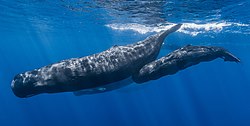| Epicynodontia Temporal range: Late Permian-Present, | |
|---|---|
 | |
| Skeleton of Thrinaxodon liorhinus , a basal epicynodont | |
 | |
| Sperm whale, a modern-day epicynodont | |
| Scientific classification | |
| Kingdom: | Animalia |
| Phylum: | Chordata |
| Clade: | Synapsida |
| Clade: | Therapsida |
| Clade: | Cynodontia |
| Clade: | Epicynodontia Hopson & Kitching, 2001 |
| Subgroups | |
Epicynodontia is a clade of cynodont therapsids that includes most cynodonts, such as galesaurids, thrinaxodontids, and Eucynodontia (including mammals). It was erected as a stem-based taxon by Hopson and Kitching (2001) and defined as the most inclusive clade containing Mammalia and excluding Procynosuchus , a Late Permian genus that is one of the most basal cynodonts. [1]
Below is a cladogram from Pusch et al. (2023) showing one hypothesis of cynodont relationships: [2]





